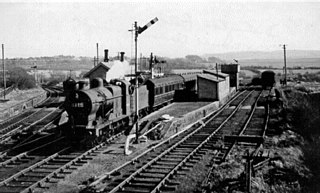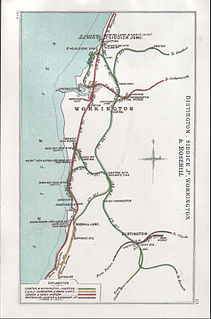
Aspatria is a railway station on the Cumbrian Coast Line, which runs between Carlisle and Barrow-in-Furness via Whitehaven. The station, situated 20 miles (32 km) south-west of Carlisle, serves the village of Aspatria, Allerdale in Cumbria, England. It is owned by Network Rail and managed by Northern Trains.

Wigton is a railway station on the Cumbrian Coast Line, which runs between Carlisle and Barrow-in-Furness via Whitehaven. The station, situated 11 miles (18 km) south-west of Carlisle, serves the village of Wigton, Allerdale in Cumbria, England. It is owned by Network Rail and managed by Northern Trains.

Silloth was the terminus of the Carlisle and Silloth Bay Railway, a branch railway from Carlisle, England. The town, dock and station at Silloth were built on a greenfield site after the Carlisle & Silloth Bay Railway & Dock Act (1855) was passed. The railway provision grew with the dock and its later additions.

Lowca had two railway stations that served the village of Lowca in the former county of Cumberland, England, which is now part of Cumbria.

Baggrow is a small village situated north of the Lake District National Park in the English county of Cumbria, historically within Cumberland.

Baggrow railway station was in the former county of Cumberland, now Cumbria, England. It was a stop on the Bolton Loop of the Maryport and Carlisle Railway.

Mealsgate is a village in Cumbria England, historically within Cumberland.

Workington Central railway station was opened by the Cleator and Workington Junction Railway (C&WJR) in 1879 to serve the town of Workington in Cumberland, England. It was situated almost half a mile nearer the town centre than its rival Workington station.

Bullgill or Bull Gill was a railway station on the Maryport and Carlisle Railway (M&CR) serving Bullgill in Cumbria. The station was opened by the M&CR in 1840 and lay in the Parish of Oughterside and Allerby.

Distington railway station was opened jointly by the Cleator and Workington Junction Railway (C&WJR) and the LNWR and Furness Joint Railway on 1 October 1879. It was situated on the northern edge of the village of Distington, Cumbria, England where the C&WJR's north-south main line crossed the Joint Line's east-west Gilgarran Branch.

Harrington railway station, or Church Road halt, was a railway station in Harrington, Cumbria, England. It was opened by the Cleator and Workington Junction Railway (C&WJR) on the company's Harrington Branch which connected with the Lowca Light Railway at Rosehill to provide a through route from Lowca to Workington Central and beyond.

Linefoot railway station, sometimes referred to as Linefoot Junction and sometimes as Linefoot Goods, briefly served the scattered community around the crossroads at Linefoot, near Cockermouth in Cumberland, England.
Micklam railway station served the fireclay mine and brickworks at Micklam, a short distance north of Lowca in the former county of Cumberland, England, which is now part of Cumbria.

Papcastle railway station was on the single track Derwent Branch of the Maryport and Carlisle Railway (M&CR) in the then county of Cumberland, now Cumbria, England.
Dovenby Lodge railway station was on the single track Derwent Branch of the Maryport and Carlisle Railway (M&CR) in the then county of Cumberland, now Cumbria, England.

Dearham railway station was on the single track Derwent Branch of the Maryport and Carlisle Railway (M&CR) in the then county of Cumberland, now Cumbria, England.
Mealsgate railway station was in the former county of Cumberland, now Cumbria, England. It was a stop on the Bolton Loop of the Maryport and Carlisle Railway.
Allhallows Colliery railway station was in the former county of Cumberland, now Cumbria, England. It was a stop on the Bolton Loop of the Maryport and Carlisle Railway.

Cumberland and Westmorland Convalescent Institution railway station was a terminus off the short Blitterlees Branch off the Carlisle and Silloth Bay Railway, within Silloth itself. The larger railway ran from Carlisle, England. The station does not appear on standard railway maps, but it can be discerned with a magnifying glass on at least two published maps and clearest of all on the 1914 25" OS map.

Silloth Battery Extension railway station was the terminus of the Blitterlees Branch, which turned southwards off the Carlisle and Silloth Bay Railway's Silloth Branch a short distance east of Silloth station. The larger railway ran from Carlisle, England. The Bitterlees Branch does not appear on standard railway maps, but it is clear on OS maps, though the station is not identifiable as such.













